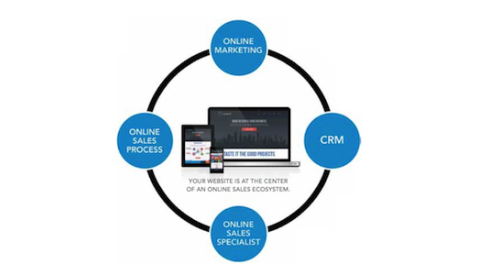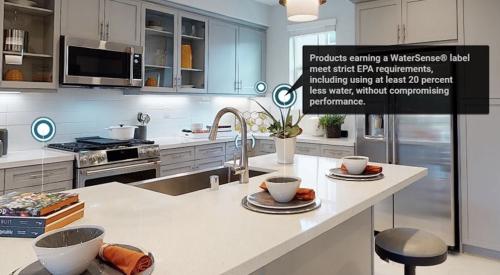According to Internet intelligence firm Cyveillance, more than 147 million Americans currently use the Internet. The average user has a college education and strong buying power, giving builders a giant clue about how to reach this critical home buying audience.
The NAHB’s March 2000 survey reported that 29% of home builder respondents had Web sites, and 27% planned to launch sites within the following six months. It follows that, as of this writing, more than 50% of builders have a Web presence of some type, and that might be conservative.
While many builders have merged onto the information superhighway, most have yet to embrace the marketing power of this exciting medium. Lest builders doubt the wisdom of folding Internet marketing into their development kits, research analysts at Solomon Smith Barney project that the Internet will handle virtually every aspect of the home building process within the next three to five years. At the production level, the Internet will consolidate and streamline the entire supply chain for materials purchasing (business-to-business in the real estate industry is one of the five fastest-growing segments online). For consumers, analysts project that prospective buyers will increasingly let their keyboards do the walking to “qualify” homes for a visit. While this might mean that expensive print advertising has become a less effective vehicle, the good news is that the Internet brings significantly reduced marketing costs for savvy new home marketers.
A tour of builder Web sites reveals a virtual custom neighborhood of approaches, some of which are effective as serious marketing venues, but many of which are not. Just as a model home is furnished to get its visitors dreaming about how their house would look, a Web site must ignite the imagination of visitors and leave them wanting to visit the neighborhood as quickly as possible. If the site doesn’t produce leads for your sales force, it probably wouldn’t produce model traffic even for Frank Lloyd Wright. Remaining focused on this point is the first step in differentiating sites that work from sites that don’t. Measuring and quantifying a site’s effectiveness is the second step.
A Personal Journey
When my husband and I recently set out to buy a home, we knew what we wanted: privacy, a dedicated guest room, and a back yard big enough to provide years of enjoyment for our two little girls. Mostly, we needed to be close to our workplaces, having endured dual three-hour round-trip commutes for nearly three years. These were the only things on our “list.” Price was important, but we had a pretty broad range within which to work. We had no set plans to buy new versus resale, no particular builder in mind, just a desire to improve our lifestyle.
With our list in hand, we set out in search of our dream home. Our first stop? The Internet, where we quickly found portal sites such as Realtor.com, numerous individual agent sites, and others that gave us lots of information on resale opportunities. A Yahoo! search on “new homes in san diego” produced three home developer Web site listings among the top 30, one of which offered a neighborhood in the general area where we were looking. We reviewed that site in search of anything that indicated it had the things on our “list.” We were not wowed by graphics, not “sold” by bells and whistles ... we were in search of “our” facts.
That experience led us to learn about the master-planned community within which this neighborhood resided, but the community did not have a Web site. Based on this initial research, we took a long lunch to visit the builder’s model homes. From there, we found other builders within the same master plan and eventually found the home we purchased.
Did the Web play a key role in our decision-making process? Yes and no. It guided us in the direction we needed to go but was not helpful in terms of researching our master plan or our builder (one of the top five in the nation, who has since launched a much more effective Web site).
|
As my experience illustrates, Web sites that work respond to the expectations of today’s online customers while preparing to meet the evolving needs of tomorrow’s buyers, all to help them make comfortable decisions. I expected to find information on my master-planned community. A Web site with links to all of the projects offered would have simplified our search, better equipping us to enter the sales office. Did this shortfall prevent us from buying? No. But it did not assist in our decision either. In five years, it might have had a much stronger impact in one way or the other.
Constructing an effective, user-friendly Web presence need not be a daunting task — especially in an industry loaded with creative talent. Several fundamental steps can significantly enhance the marketing effectiveness of any site.
The most effective home building Web sites are not necessarily those of the large, well-entrenched developers. In fact, some of the largest developers are playing catch-up in the Web game. The ultimate goal of a Web site is to serve as a global ambassador, extending the builder’s marketing reach and sales center through an exciting new medium that is becoming mainstream at a dramatic pace. Many smaller builders have done this very well.
An effective Web presence should do several things:
These criteria need not require substantial resources to implement. What they do require is forethought and a strategic mind-set. It is critical that you assess the role of the Internet in your overall communications program and design a road map before setting out. In addition to strategy, whether your site includes 10 pages or 1,000, several fundamental principles of e-marketing will increase its effectiveness.
Search Engine Positioning
In today’s home buying climate, rare is a potential home buyer who has not used the Web for at least some research. More often than not, buyers begin by calling up a search engine and typing in words such as “new home” or “real estate.” From these search results, one site often leads to the next, which leads to the next, and so on. An effective search engine presence will get your site near the top of those search results. This is especially true for builders targeting long-distance shoppers in the relocation market and for smaller builders without the resources to advertise aggressively in traditional media.
Effective search engine positioning is a game with an ever-expanding and ever-changing rulebook. There are fundamental tasks (with which a good Web developer would be familiar) to optimize a site so it will be highly visible to the search engines. Be careful — really “cool” functionality such as splash pages built with Flash technology can negatively affect positioning, so be sure your developer makes you aware of any trade-offs. You can also take a more proactive approach and submit your site directly to many of the engines.
As search engines struggle to maintain editorial integrity and keep a firm line between paid advertisements and objective listings, other sites are taking the pay-for-listing approach. Several of the most popular mainstream directories now require a $199 registration fee. This doesn’t guarantee placement, only that your site will be considered for listing. Other engines are participating in a fairly new program called “sponsored” or “premium” listings, paid listings that appear above or below the nonpaid top-10 listings on the first search results page. The program is paid for on a cost-per-click basis rather than a straight impression basis, so the traffic you pay for is highly targeted. The current model calls for establishment of a “kitty” account with a given value (say $1,000). That account is then debited each time a click-through occurs (current rate is approximately a dime a click) until the money is gone or the program renewed. Both of these programs are in their infancy, and pricing will no doubt continue to climb.
In addition to the primary search engines, several sites specifically target the new home buyer. Sites such as HomeBuilder.com, Builder Homesite, NewHomeNetwork.com and others offer basic listings at little or no cost, and then up-sell expanded listings, banner advertisements, e-mail inclusion and other services. Remember that when negotiating for Web advertising of any kind, you can (and should) always demand performance guarantees and accountability. These services can enhance your visibility online, but don’t expect them to single-handedly bring you a tremendous amount of traffic.
Permission Marketing
Permission marketing ... relationship marketing ... one-to-one marketing ... customer relationship management. You’ve probably heard all of these terms and struggled to understand the difference. There really is none. This concept boils down to establishing a relationship, based on respect, with potential and existing customers, and then facilitating that relationship with the benefit of technology.
A home builder’s most fundamental application of permission marketing is the effective use of e-mail as a low-cost mechanism for developing an ongoing dialogue with potential customers. Whether forming an interest list before a grand opening or collecting qualified leads when sales are in full swing, e-mail allows you into the homes of potential customers on a regular basis because you have their permission to be there.
Your job is to respect that permission and to provide current, relevant and timely information about the status of your project. It is also important to be aware of the laws surrounding e-mail communication and adhere to these at all costs.
More sophisticated promotions can also be implemented easily and inexpensively using e-mail as the tool. Test-marketing of special offers, refer-a-friend programs and other “viral” (word-of-mouth) marketing techniques not only prompt prospects to buy but also encourage existing homeowners to refer their friends.
Entrance into the e-mail marketing realm is easily achieved through standard Listserv technology or more sophisticated messaging programs such as UnityMail (by MessageMedia), Kana and the e2 Mail Center (by e2 Communications). Examples of basic e-mail marketing programs include monthly mailings to all list members providing updates on community progress, phase releases and company news. As new phases open, e-mail can deliver graphically formatted HTML mail content, including photos, branding elements and other visually appealing information. Studies show that graphics-based e-mails produce significantly higher click-through rates. An industry with a visual product offering has an advantage in leveraging this new technology, which is the e-mail equivalent of changing from cassette tapes to CDs (and now DVDs). The cheapest and easiest approach is to outsource your e-mail program; you receive all of the features but don’t have to deal with the headaches.
At a more personalized level, these tools can be used by sales center representatives to follow up with potential leads by providing them with updates and reminders as to waiting list status, price increase alerts, etc. After the sale, the benefits of e-mail marketing grow exponentially: as a tool to manage the post-sale process, deliver reminder notices on milestone dates, provide updates on building progress, and provide the buyers with clear and simple access to the information they need, on their terms. Collect e-mail addresses and referral information at every possible location — from your call centers to visitor centers — even if you have to provide your visitors with an incentive to do so.
| California Pacific Homes offers new homeowners an online warranty request form. Information is routed directly to customer service so follow-up can happen quickly.
|
With the right tools, permission marketing need not only be about outreach to customers. It’s also about getting to know prospects and then using this knowledge to provide the information they seek. This process mimics that of a real-life relationship. When you first meet someone, you typically don’t ask deeply personal questions but rather share more superficial information about each other. As you get to know each other and the relationship evolves, you share more meaningful information. This process continues as the relationship develops.
So it should be with permission marketing. You begin by collecting basic information about potential customers through a registration or contact form on your Web site. Perhaps you ask when they intend to purchase a home. If they say six months, you can take that information and follow up six months down the road with a personalized message asking how they’re progressing with their home buying decision and offering any assistance they might need. You engage the customers and request their feedback. Based on this, you gain a significant amount of market research information and make potential customers feel a part of your community, whether they have purchased a home or not.
While you might not be prepared to offer a fully Web-enabled customer service program, the inclusion of homeowner care information on your Web site gives new buyers a sense of community while providing current homeowners a reason to return to the site. Posting and e-mail distribution of community newsletters, calendars of events, design center processes and resources, home improvement/maintenance tips, online warranty request forms, and other homeowner-focused information provide a feeling of community and show potential customers you value your homeowners. Some builders such as Shea Homes and Beazer already have very robust sites, including personal file folders where prospects can store their relevant information (favorite floor plan or preferred options, for example).
| The Beazer Homes site lets prospects save and compare information such as floor plans.
|
An often-overlooked element of electronic marketing is measurement. How do you know if your site works? Relying on basic traffic reports produces impressive numbers but might not offer a realistic representation of success. If your traffic is growing, obviously that’s a positive trend. But how valuable is the information if you don’t know who is coming to your site, which parts of the site they’re visiting, where they’re spending the most time and whether your site engages them?
This type of cost-effective measurement establishes solid benchmarks that will allow you to watch your site’s trends and assign success as appropriate. Simple but effective things to measure include:
Page Donovan is marketing director for Inter@ctivate Inc. (San Diego), a strategic interactive consulting firm with numerous clients in the home building industry.
E-Marketing Resources
Sponsored/premium listings: goto.com
New home directories: www.americanbuilders.com
www.americanhomeguides.com
www.builderhomesite.com
www.homebuilder.com
www.newhomesdirect.com
Online marketing consulting: Inter@ctivate Inc., www.interactivate.com
e2 Communications: www.e2communications.comKana: www.kana.com
Also See










